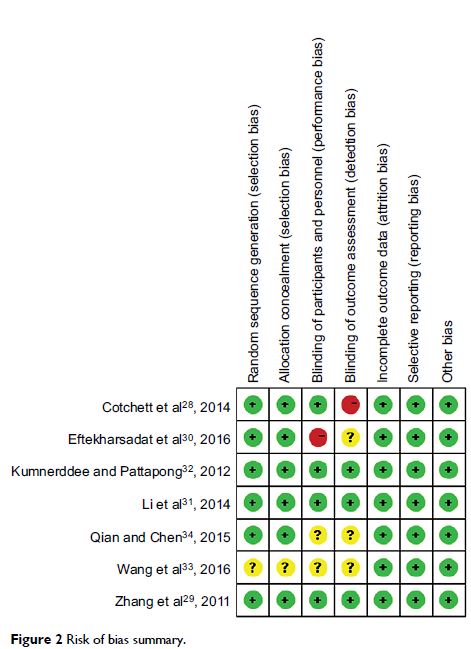9 0 6 7 6
论文已发表
注册即可获取德孚的最新动态
IF 收录期刊
- 2.6 Breast Cancer (Dove Med Press)
- 3.9 Clin Epidemiol
- 3.3 Cancer Manag Res
- 3.9 Infect Drug Resist
- 3.6 Clin Interv Aging
- 4.8 Drug Des Dev Ther
- 2.8 Int J Chronic Obstr
- 8.0 Int J Nanomed
- 2.3 Int J Women's Health
- 3.2 Neuropsych Dis Treat
- 4.0 OncoTargets Ther
- 2.2 Patient Prefer Adher
- 2.8 Ther Clin Risk Manag
- 2.7 J Pain Res
- 3.3 Diabet Metab Synd Ob
- 4.3 Psychol Res Behav Ma
- 3.4 Nat Sci Sleep
- 1.9 Pharmgenomics Pers Med
- 3.5 Risk Manag Healthc Policy
- 4.5 J Inflamm Res
- 2.3 Int J Gen Med
- 4.1 J Hepatocell Carcinoma
- 3.2 J Asthma Allergy
- 2.3 Clin Cosmet Investig Dermatol
- 3.3 J Multidiscip Healthc

触发点干针刺治疗脚底痛的有效性:七项随机对照试验的荟萃分析
Authors He C, Ma H
Received 11 May 2017
Accepted for publication 26 July 2017
Published 18 August 2017 Volume 2017:10 Pages 1933—1942
DOI https://doi.org/10.2147/JPR.S141607
Checked for plagiarism Yes
Review by Single-blind
Peer reviewers approved by Dr Minal Joshi
Peer reviewer comments 2
Editor who approved publication: Dr E. Alfonso Romero-Sandoval
Background: Plantar
heel pain can be managed with dry needling of myofascial trigger points
(MTrPs); however, whether MTrP needling is effective remains controversial.
Thus, we conducted this meta-analysis to evaluate the effect of MTrP needling
in patients with plantar heel pain.
Materials and
methods: PubMed, Embase, Web of
Science, SinoMed (Chinese BioMedical Literature Service System, People’s
Republic of China), and CNKI (National Knowledge Infrastructure, People’s
Republic of China) databases were systematically reviewed for randomized
controlled trials (RCTs) that assessed the effects of MTrP needling. Pooled
weighted mean difference (WMD) with 95% CIs were calculated for change in
visual analog scale (VAS) score, and pooled risk ratio (RR) with 95% CIs were
calculated for success rate for pain and incidence of adverse events. A
fixed-effects model or random-effects model was used to pool the estimates,
depending on the heterogeneity among the included studies.
Results: Extensive literature search yielded 1,941 articles, of which only seven
RCTs met the inclusion criteria and were included in this meta-analysis. The
pooled results showed that MTrP needling significantly reduced the VAS score
(WMD =–15.50, 95% CI: –19.48, –11.53; P <0.001)
compared with control, but it had a similar success rate for pain with control
(risk ratio [RR] =1.15, 95% CI: 0.87, 1.51; P =0.320).
Moreover, MTrP needling was associated with a similar incidence of adverse
events with control (RR =1.89, 95% CI: 0.38, 9.39; P =0.438).
Conclusion: MTrP needling effectively reduced the heel pain due to plantar
fasciitis. However, considering the potential limitations in this study, more
large-scale, adequately powered, good-quality placebo-controlled trials are
needed to provide more trustworthy evidence in this area.
Keywords: plantar heel pain, myofascial trigger points, dry needling
